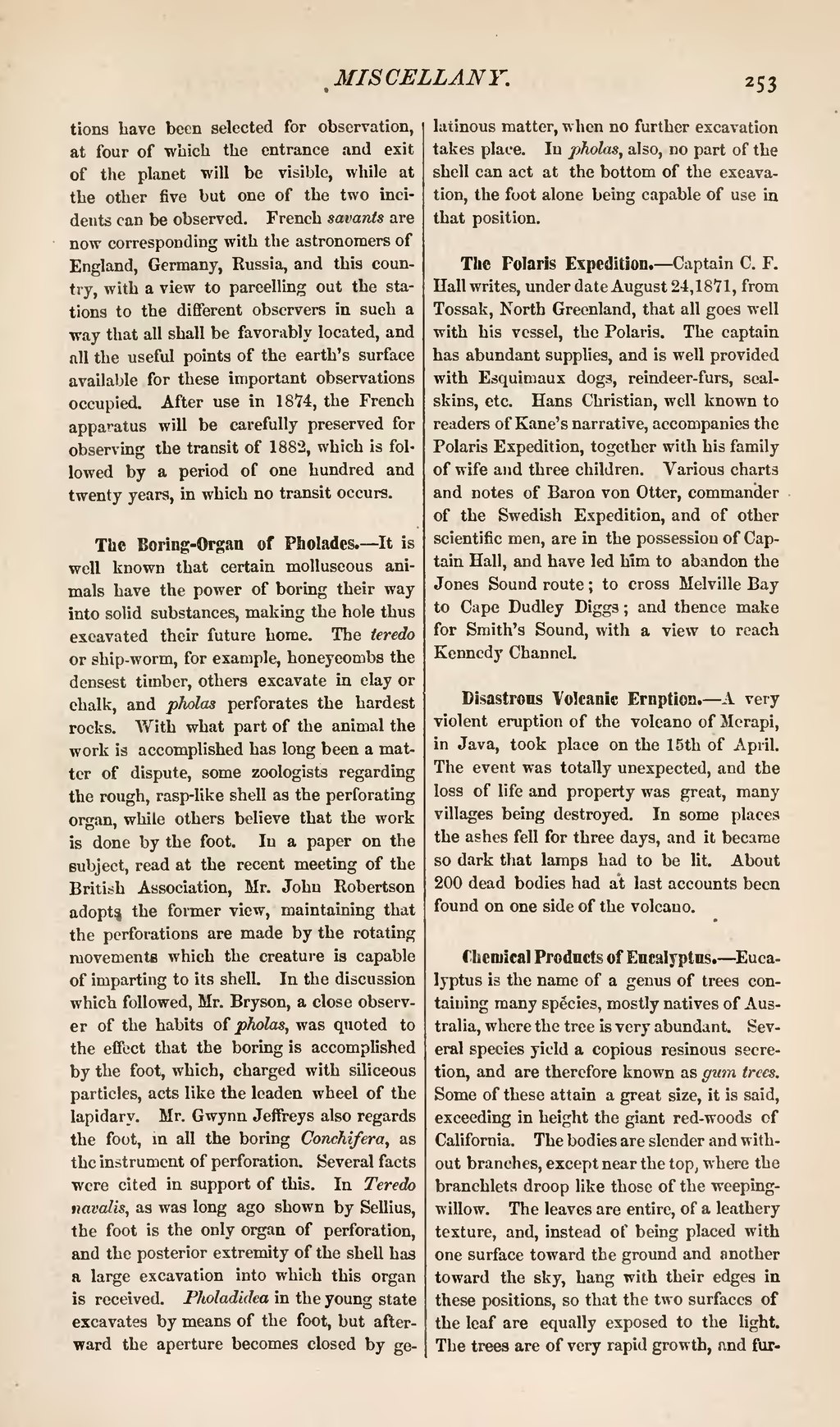tions have been selected for observation, at four of which the entrance and exit of the planet will be visible, while at the other five but one of the two incidents can be observed. French savants are now corresponding with the astronomers of England, Germany, Russia, and this country, with a view to parcelling out the stations to the different observers in such a way that all shall be favorably located, and all the useful points of the earth's surface available for these important observations occupied. After use in 1874, the French apparatus will be carefully preserved for observing the transit of 1882, which is followed by a period of one hundred and twenty years, in which no transit occurs.
The Boring-Organ of Pholades.—It is well known that certain molluseous animals have the power of boring their way into solid substances, making the hole thus excavated their future home. The teredo or ship-worm, for example, honeycombs the densest timber, others excavate in clay or chalk, and pholas perforates the hardest rocks. With what part of the animal the work is accomplished has long been a matter of dispute, some zoologists regarding the rough, rasp-like shell as the perforating organ, while others believe that the work is done by the foot. In a paper on the subject, read at the recent meeting of the British Association, Mr. John Robertson adopts, the former view, maintaining that the perforations are made by the rotating movements which the creature is capable of imparting to its shell. In the discussion which followed, Mr. Bryson, a close observer of the habits of pholas, was quoted to the effect that the boring is accomplished by the foot, which, charged with siliceous particles, acts like the leaden wheel of the lapidary. Mr. Gwynn Jeffreys also regards the foot, in all the boring Conchifera, as the instrument of perforation. Several facts were cited in support of this. In Teredo navalis, as was long ago shown by Sellius, the foot is the only organ of perforation, and the posterior extremity of the shell has a large excavation into which this organ is received. Pholadideain the young state excavates by means of the foot, but afterward the aperture becomes closed by gelatinous matter, when no further excavation takes place. In pholas, also, no part of the shell can act at the bottom of the excavation, the foot alone being capable of use in that position.
The Polaris Expedition.—Captain C. F. Hall writes, under date August 24,1871, from Tossak, North Greenland, that all goes well with his vessel, the Polaris. The captain has abundant supplies, and is well provided with Esquimaux dogs, reindeer-furs, seal-skins, etc. Hans Christian, well known to readers of Kane's narrative, accompanies the Polaris Expedition, together with his family of wife and three children. Various charts and notes of Baron von Otter, commander of the Swedish Expedition, and of other scientific men, are in the possession of Captain Hall, and have led him to abandon the Jones Sound route; to cross Melville Bay to Cape Dudley Diggs; and thence make for Smith's Sound, with a view to reach Kennedy Channel.
Disastrous Volcanic Eruption.—A very violent eruption of the volcano of Merapi, in Java, took place on the 15th of April. The event was totally unexpected, and the loss of life and property was great, many villages being destroyed. In some places the ashes fell for three days, and it became so dark that lamps had to be lit. About 200 dead bodies had at last accounts been found on one side of the volcano.
Chemical Products of Eucalyptus.—Eucalyptus is the name of a genus of trees containing many species, mostly natives of Australia, where the tree is very abundant. Several species yield a copious resinous secretion, and are therefore known as gum trees. Some of these attain a great size, it is said, exceeding in height the giant red-woods of California. The bodies are slender and without branches, except near the top, where the branchlets droop like those of the weeping-willow. The leaves are entire, of a leathery texture, and, instead of being placed with one surface toward the ground and another toward the sky, hang with their edges in these positions, so that the two surfaces of the leaf are equally exposed to the light. The trees are of very rapid growth, and fur-
